overheating CADILLAC CATERA 1997 1.G Owners Manual
[x] Cancel search | Manufacturer: CADILLAC, Model Year: 1997, Model line: CATERA, Model: CADILLAC CATERA 1997 1.GPages: 338, PDF Size: 18.02 MB
Page 129 of 338
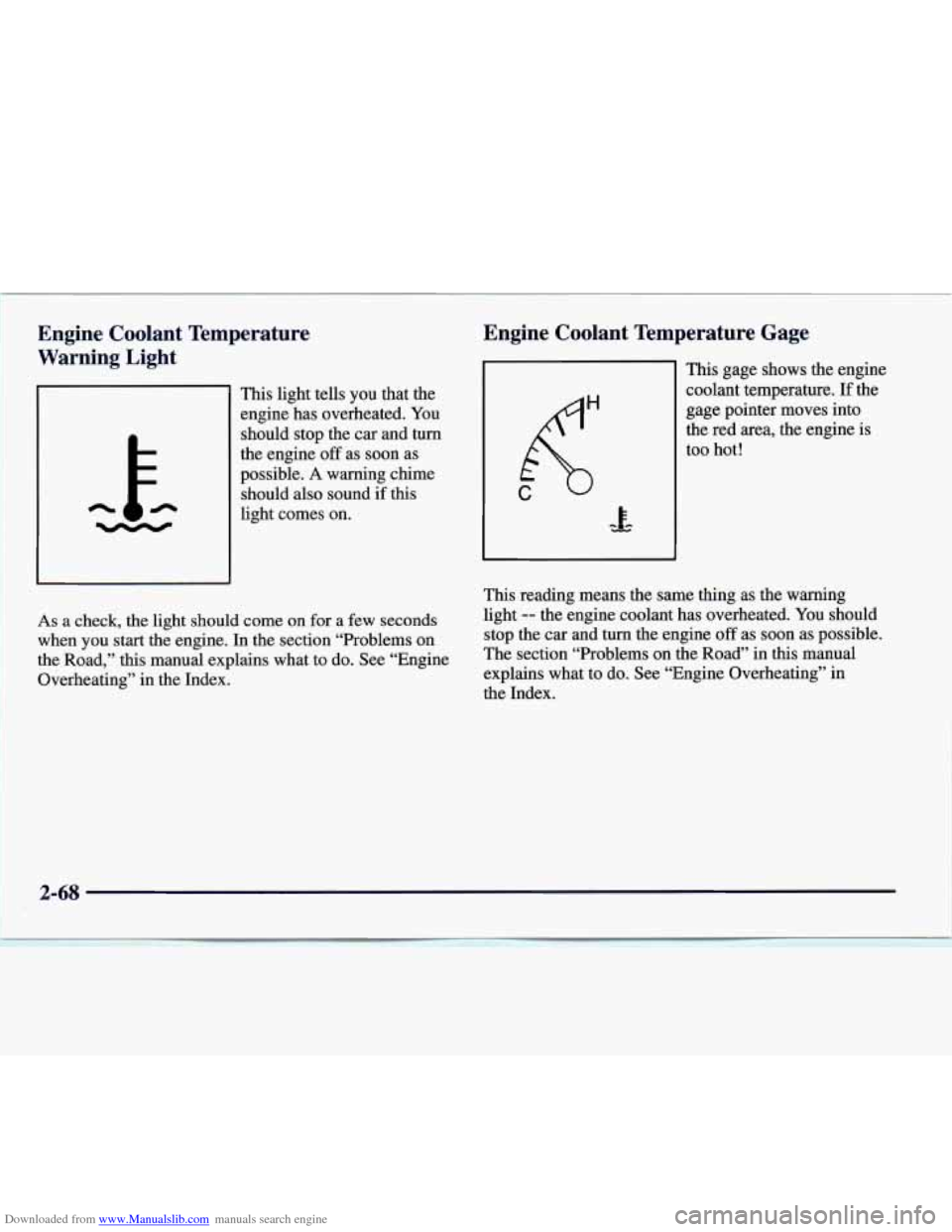
Downloaded from www.Manualslib.com manuals search engine Engine Coolant Temperature
Warning Light
This light tells you that the
engine has overheated. You
should stop the
car and turn
the engine
off as soon as
possible.
A warning chime
should also sound if
this
light comes on.
As a check, the light should come on for a few seconds
when you
start the engine. In the section “Problems on
the Road,” this manual explains what to do. See “Engine
Overheating” in the Index.
Engine Coolant Temperature Gage
C &
This gage shows the engine
coolant temperature.
If the
gage pointer moves into
the red area, the engine
is
too hot!
This reading means the same thing as the warning
light
-- the engine coolant has overheated. You should
stop the car and turn the engine off as soon as possible.
The section “Problems on the Road” in this manual
explains what to do. See “Engine Overheating” in
the Index.
I 2-68
Page 204 of 338
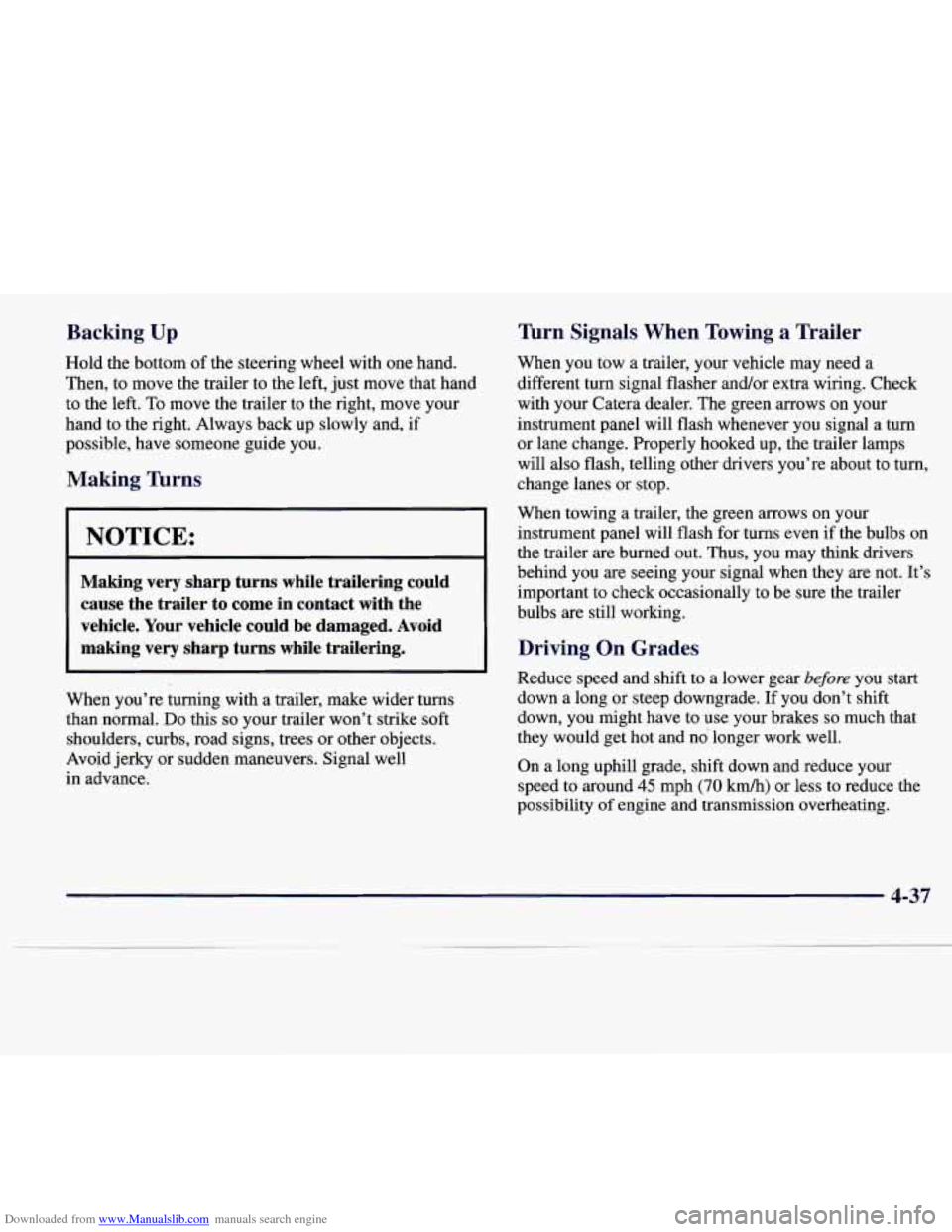
Downloaded from www.Manualslib.com manuals search engine Backing Up
Hold the bottom of the steering wheel with one hand.
Then, to move the trailer to the left, just move that hand
to the left.
To move the trailer to the right, move your
hand to the right. Always back up slowly and, if
possible, have someone guide you.
Making Turns
NOTICE:
Making very sharp turns while trailering could
cause the trailer
to come in contact with the
vehicle.
Your vehicle could be damaged. Avoid
making very sharp turns while trailering.
1
When you’re turning with a trailer, make wider turns
than normal.
Do this so your trailer won’t strike soft
shoulders, curbs, road signs, trees or other objects.
Avoid jerky or sudden maneuvers. Signal well
in advance.
lbrn Signals When Towing a Trailer
When you tow a trailer, your vehicle may need a
different turn signal flasher and/or extra wiring. Check
with your Catera dealer. The green arrows
on your
instrument panel will flash whenever you signal a turn
or lane change. Properly hooked up, the trailer lamps
will
also flash, telling other drivers you’re about to turn,
change lanes or stop.
When towing a trailer,
the green arrows on your
instrument panel will flash for turns even if the bulbs on
the trailer are burned out. Thus, you may think drivers
behind you are seeing your signal when they are not. It’s
important to check occasionally
to be sure the trailer
bulbs are still working.
Driving On Grades
Reduce speed and shift to a lower gear before you start
down a long
or steep downgrade. If you don’t shift
down, you might have to use your brakes
so much that
they would get hot and no longer work well.
On a long uphill grade, shift down and reduce your
speed to around
45 mph (70 km/h) or less to reduce the
possibility of engine and transmission overheating.
4-37
Page 208 of 338
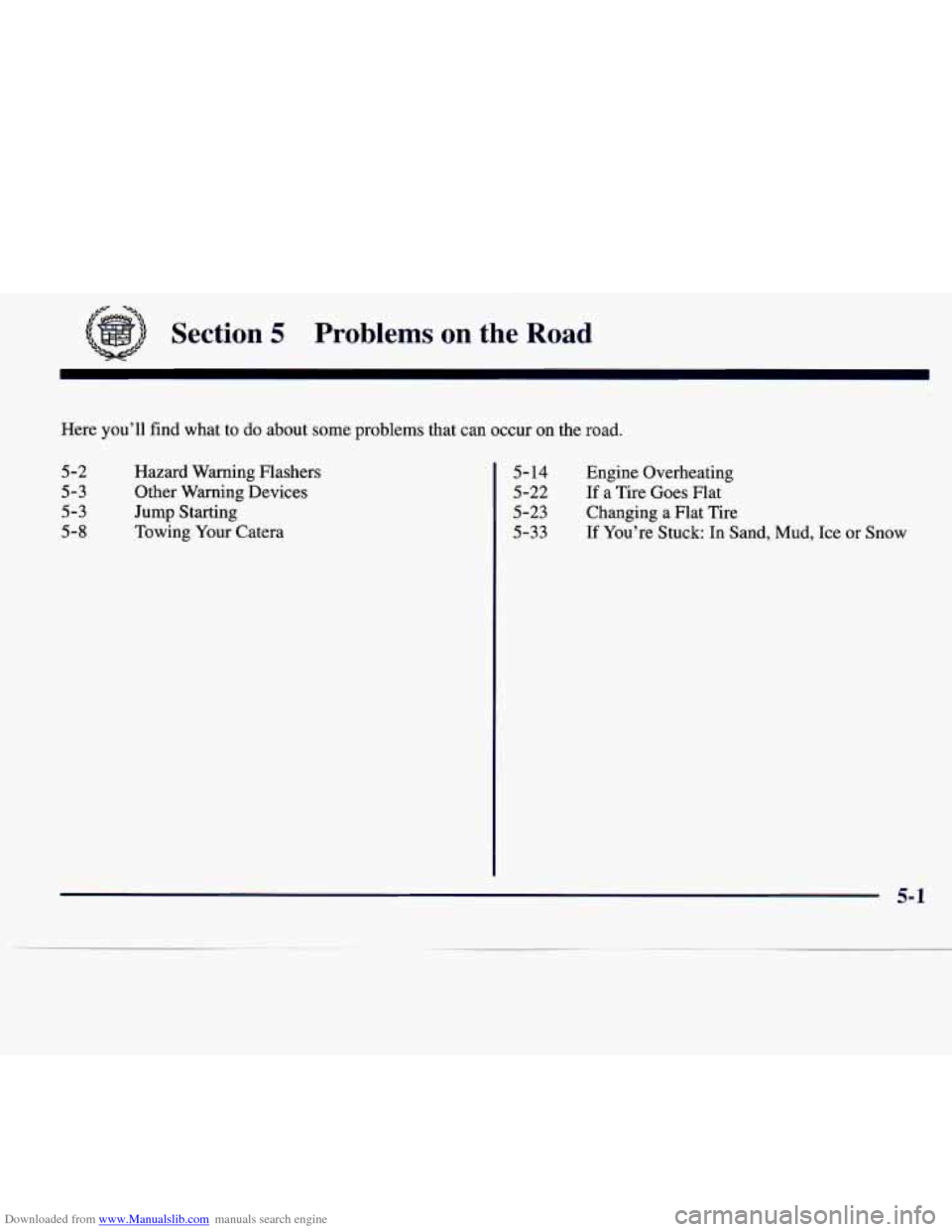
Downloaded from www.Manualslib.com manuals search engine Section 5 Problems on the Road
Here you’ll find what to do about some problems that can occur on the road.
5-2
5-3
5-3
5-8
Hazard Warning Flashers
Other Warning Devices
Jump Starting
Towing Your Catera 5- 14
5-22
5-23
5-33
Engine Overheating
If a Tire Goes Flat
Changing a Flat Tire
If You’re Stuck: In Sand, Mud, Ice or Snow
5- 1
Page 221 of 338
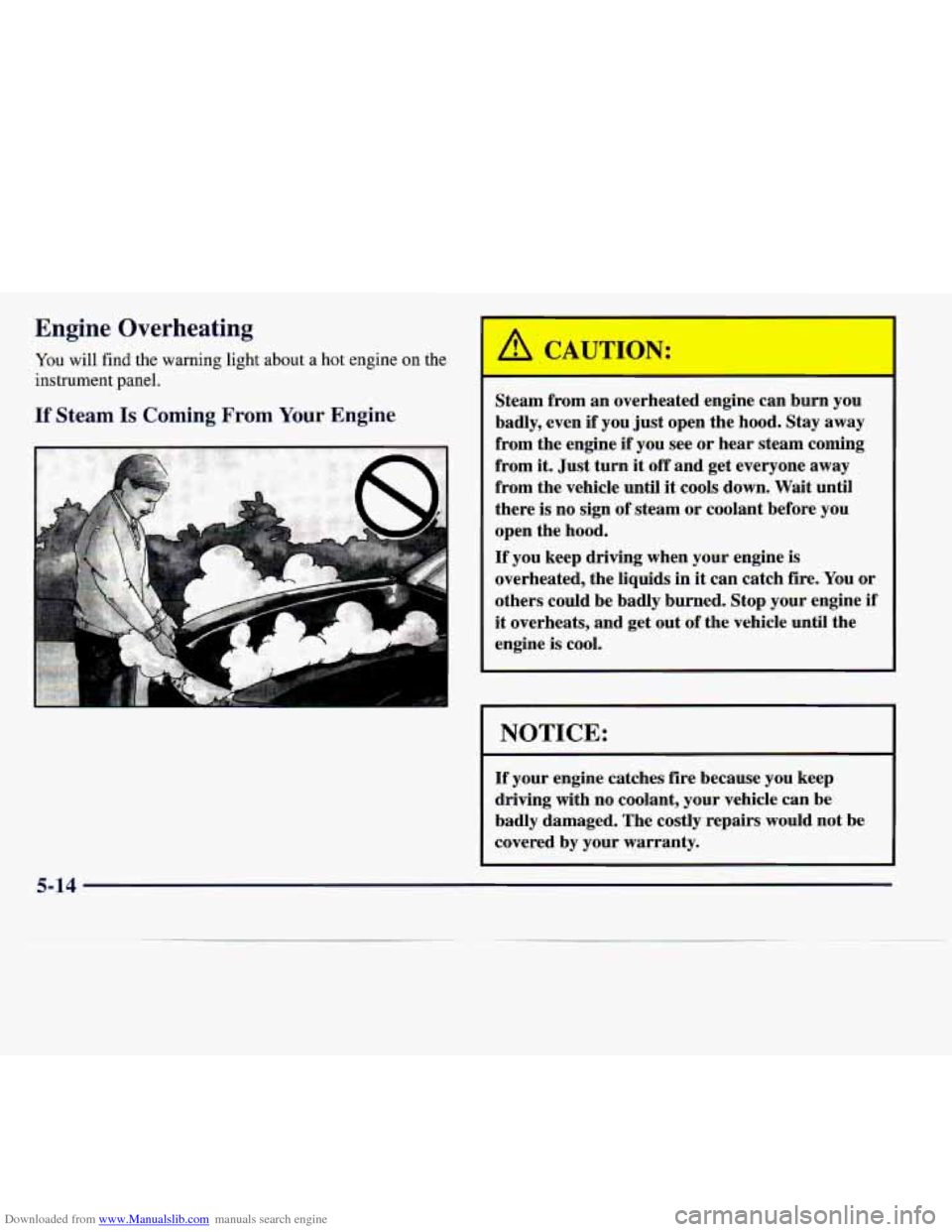
Downloaded from www.Manualslib.com manuals search engine Engine Overheating
You will find the warning light about a hot engine on the
instrument panel.
If Steam Is Coming From Your Engine
1.
4 CAUTION:
Steam from an overheated engine can burn you
badly, even
if you just open the hood. Stay away
from the engine if you see or hear steam coming
from
it. Just turn it off and get everyone away
from the vehicle until
it cools down. Wait until
there is no sign
of steam or coolant before you
open the hood.
If you keep driving when your engine is
overheated, the liquids in it can catch fire. You or
others could be badly burned. Stop your engine if
it overheats, and get out
of the vehicle until the
engine
is cool.
I NOTICE:
If your engine catches fire because you keep
driving with
no coolant, your vehicle can be
badly damaged. The costly repairs would not be
covered by your warranty.
5-14
Page 224 of 338
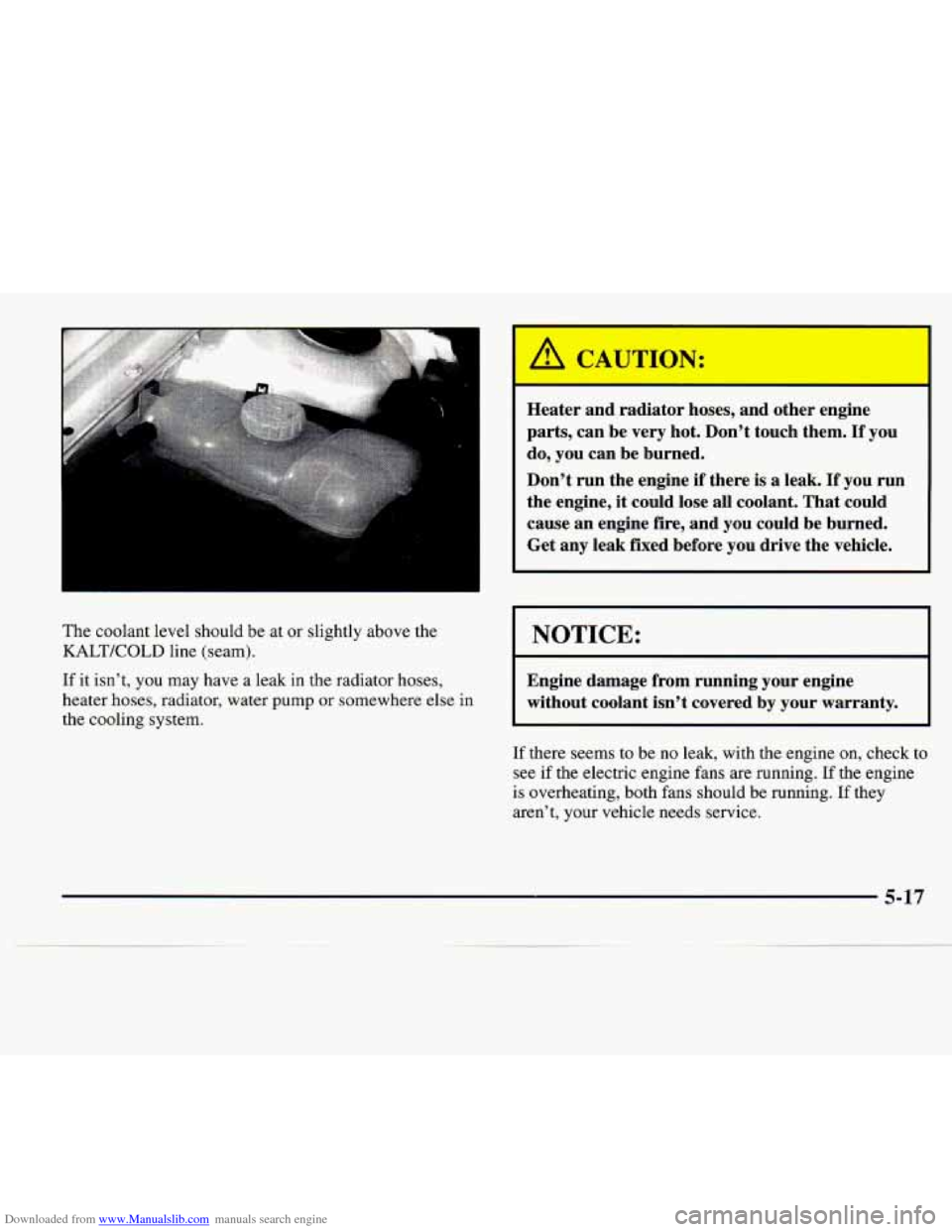
Downloaded from www.Manualslib.com manuals search engine The coolant level should be at or slightly above the
KALTKOLD line (seam).
If it isn’t, you may have a leak in the radiator hoses,
heater hoses, radiator, water pump
or somewhere else in
the cooling system.
I A C A UTION:
Heater and radiator hoses, and other engine
parts, can be very hot. Don’t touch them.
If you
do, you can be burned.
Don’t run the engine
if there is a leak. If you run
the engine, it could lose all coolant. That could
cause an engine fire, and
you could be burned.
Get any leak fixed before you drive the vehicle.
NOTICE:
Engine damage from running your engine
without coolant isn’t covered by your warranty.
If there seems to be no leak, with the engine on, check to
see if the electric engine fans are running. If the engine
is overheating, both fans should be running. If they
aren’t, your vehicle needs service.
5-17
Page 262 of 338
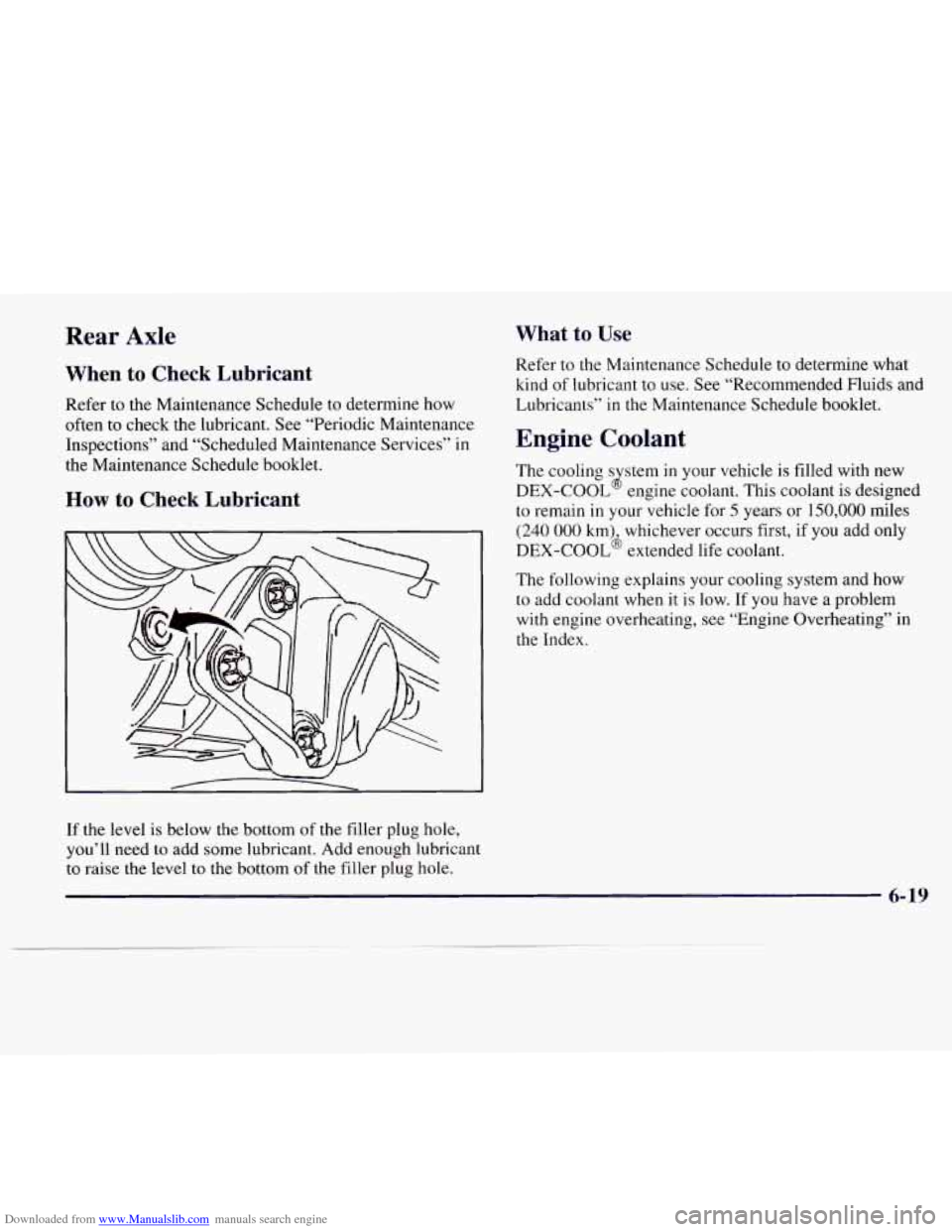
Downloaded from www.Manualslib.com manuals search engine Rear Axle
When to Check Lubricant
Refer to the Maintenance Schedule to determine how
often to check the lubricant. See “Periodic Maintenance
Inspections” and “Scheduled Maintenance Services” in
the Maintenance Schedule booklet.
How to Check Lubricant
I
What to Use
Refer to the Maintenance Schedule to determine what
kind
of lubricant to use. See “Recommended Fluids and
Lubricants” in
the Maintenance Schedule booklet.
Engine Coolant
The cooling s stem in your vehicle is filled with new
DEX-COOL
J engine coolant. This coolant is designed
to remain in your vehicle for
5 years or 150,000 miles
(240 000 km) whichever occurs first, if you add only
DEX-COOL6 extended life coolant.
The following explains your cooling system and how
to add coolant when it is low. If
you have a problem
with engine overheating, see “Engine Overheating” in
the Index.
If the level is below the bottom of the filler plug hole,
you’ll need
to add some lubricant. Add enough lubricant
to raise the level to the bottom of the filler plug hole.
6- 19
Page 266 of 338
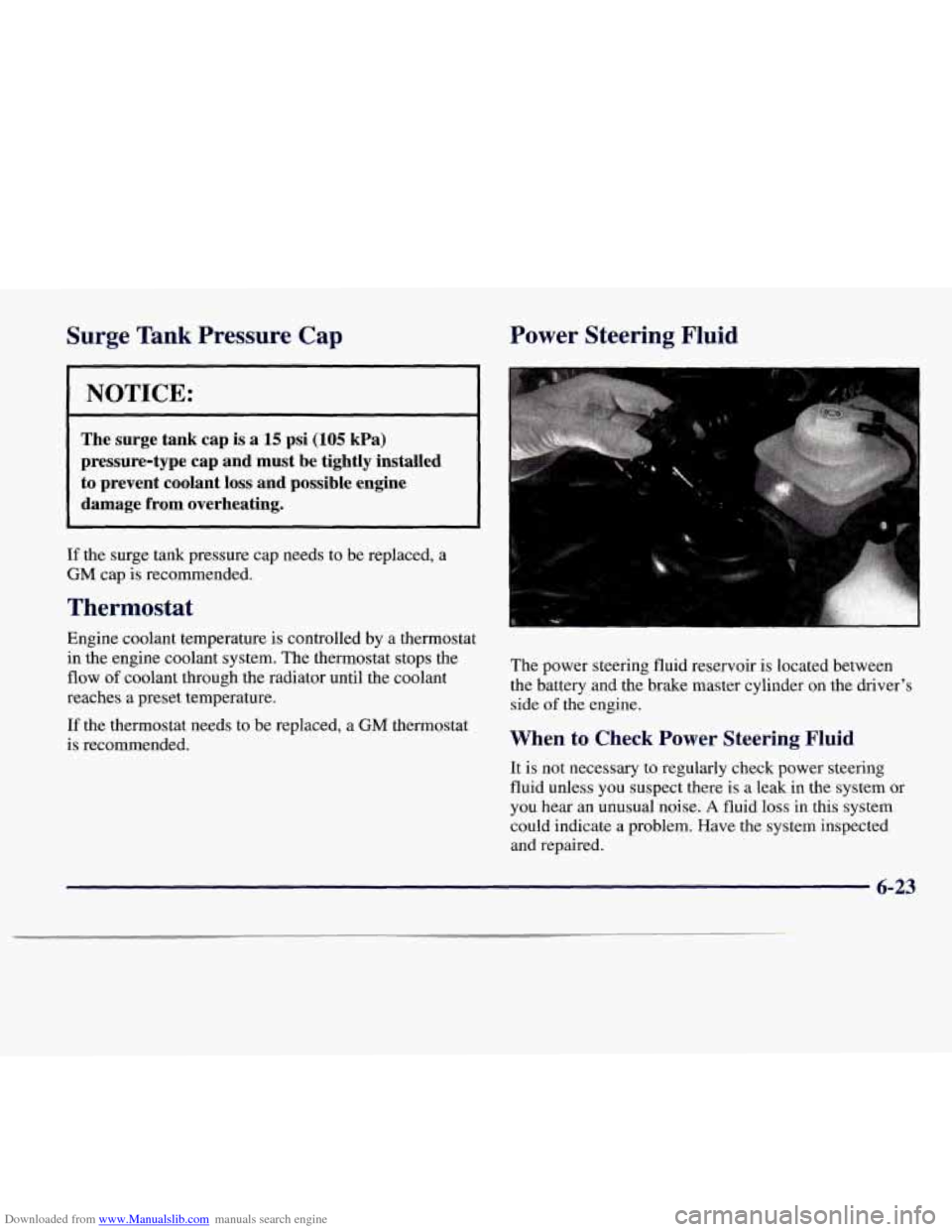
Downloaded from www.Manualslib.com manuals search engine Surge Tank Pressure Cap Power Steering Fluid
NOTICE:
The surge tank cap is a 15 psi (105 kPa)
pressure-type cap and must be tightly installed to prevent coolant loss and possible engine
damage from overheating.
If the surge tank pressure cap needs to be replaced, a
GM cap is recommended.
Thermostat
Engine coolant temperature is controlled by a thermostat
in the engine coolant system. The thermostat stops the
flow
of coolant through the radiator until the coolant
reaches a preset temperature.
If the thermostat needs to be replaced, a GM thermostat
is recommended. The
power steering fluid reservoir
is located between
the battery and the brake master cylinder on the driver’
side
of the engine.
When to Check Power Steering Fluid
It is not necessary to regularly check power steering
fluid unless you suspect there is a leak in the system or
you hear an unusual noise. A fluid loss in this system
could indicate a problem. Have the system inspected
and repaired.
6-23
Page 281 of 338
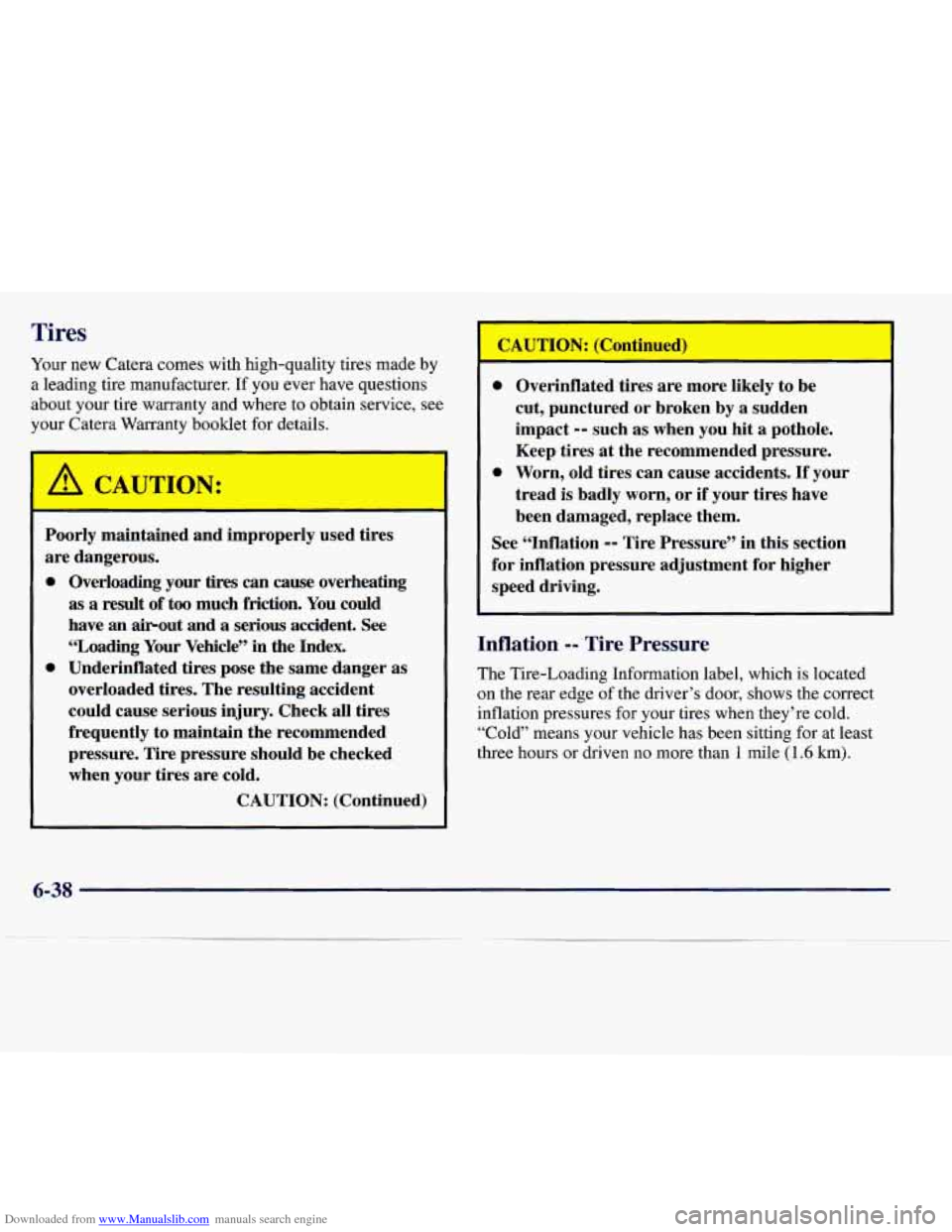
Downloaded from www.Manualslib.com manuals search engine Tires
Your new Catera comes with high-quality tires made by
a leading tire manufacturer. If you ever have questions
about your tire warranty and where
to obtain service, see
your Catera Warranty booklet for details.
I
/! CAUTION:
Poorly maintained and improperly used tires
are dangerous.
0 Overloading your tires can cause overheating
as a result of too much friction. You could
have an airout and
a serious accident. See
“Loading Your Vehicle” in the Index.
0 Underinflated tires pose the same danger as
overloaded tires. The resulting accident
could cause serious injury. Check all tires
frequently to maintain the recommended
pressure. Tire pressure should be checked
when your tires are cold.
CAUTION: (Continued)
I--
@ Overinflated tires are more likely to be
cut, punctured or broken
by a sudden
impact
-- such as when you hit a pothole.
Keep tires at the recommended pressure.
0 Worn, old tires can cause accidents. If your
tread is badly worn, or
if your tires have
been damaged, replace them.
See “Inflation
-- Tire Pressure” in this section
for inflation pressure adjustment for higher
speed driving.
Inflation -- Tire Pressure
The Tire-Loading Information label, which is located
on the rear edge of the driver’s door, shows the correct
inflation pressures for your tires when they’re cold.
“Cold” means your vehicle has been sitting for
at least
three hours or driven
no more than 1 mile (1.6 km).
6-38
Page 329 of 338

Downloaded from www.Manualslib.com manuals search engine Electrmic Level Control ......................... 4-32
Emergency
Trunk Release ........................ 2-10
Compartment Relay Center
..................... 6-61
Caolant Heater
............................... 2- 17
Coolant Temperature Gage
..................... 2-68
Coolant Temperature Warning
Light .............. 2-68
Identification
................................ 6-55
Overheating ................................. 5-14
Running
While Parked ......................... 2-29
Spscificatio
ns ................................ 6-62
Smg YOU ................................ 2-16
Engine
......................................... 6-9
..................................... CoOltUlt
6-19
Exh~
st ..................................... 2-29
Engine Oil
.................................... 6-10
Adding 6-11
Additives 6- 13
Checking
................................... 6- 11
Used 6-14
.....................................
...................................
.......................................
When to Change .............................. 6-13
Engine
Speed Limiter ............................ 2-61
FmglishMetric Display
........................... 3-3
Ethan01
........................................ 6-4
Exhaust, Engine
................................ 2-29
Exteri~ Frat Bulbs ............................. 6-30
Exterior
Lamps ................................. 2-38
Exterior
RW Bulbs ............................. 6-34
Fabric
cleaning .......................... 6.46. 6.47
Fan Button. Climate Control System
................. 3-2
FillingYourTank
................................ 6-5
Filter. Air 6-15 .....................................
Filter Replacement. Passenger Compartment Air ...... 6- 17
Finish Care 6-51 ....................................
Fish Damage ................................. 6-52
First Gear. Automatic Transmission ................ 2-21
Flashers.
Hazard Warning ......................... 5-2
Flat Tire. Changing ............................. 5-23
Fog Latsps .................................... 2-42
Folding the Rear Seat
............................. 1-10
Foreign Countries. Fuel
........................... 6-5
French Language Manual
........................... ii
Front Turn Signal Lamp. Bulb Replacement .......... 6-30
Filling
Your Tank .............................. 6-5
Gage .................................. . ., ... 2-75
In Foreign Countries ........................... 6-5
Fuses and Circuit Breakers ....................... 6-57
Gages
Engine Coolant Temperature .................... 2-63
Flash-To-PassFeature
........................... 2-33
Floor Mats 2-51
....................................
Fuel .......................................... 6-3
DoorLock ................................... 6-6
....................................... Fuel 2-75 OilPressure
................................. 2-72
GarmentHooks
................................ 2-51
GAM 4-30
Glove Box 2-48
.......................................
Gear Positions. Automatic Transmission ............. 2-19
Gold
Key Courtesy Transportation .................. 7-8
Gross Axle Weight Rating ........................ 4-30
Gross Vehicle Weight Rating ...................... 4-30
....................................
8-4
Page 332 of 338
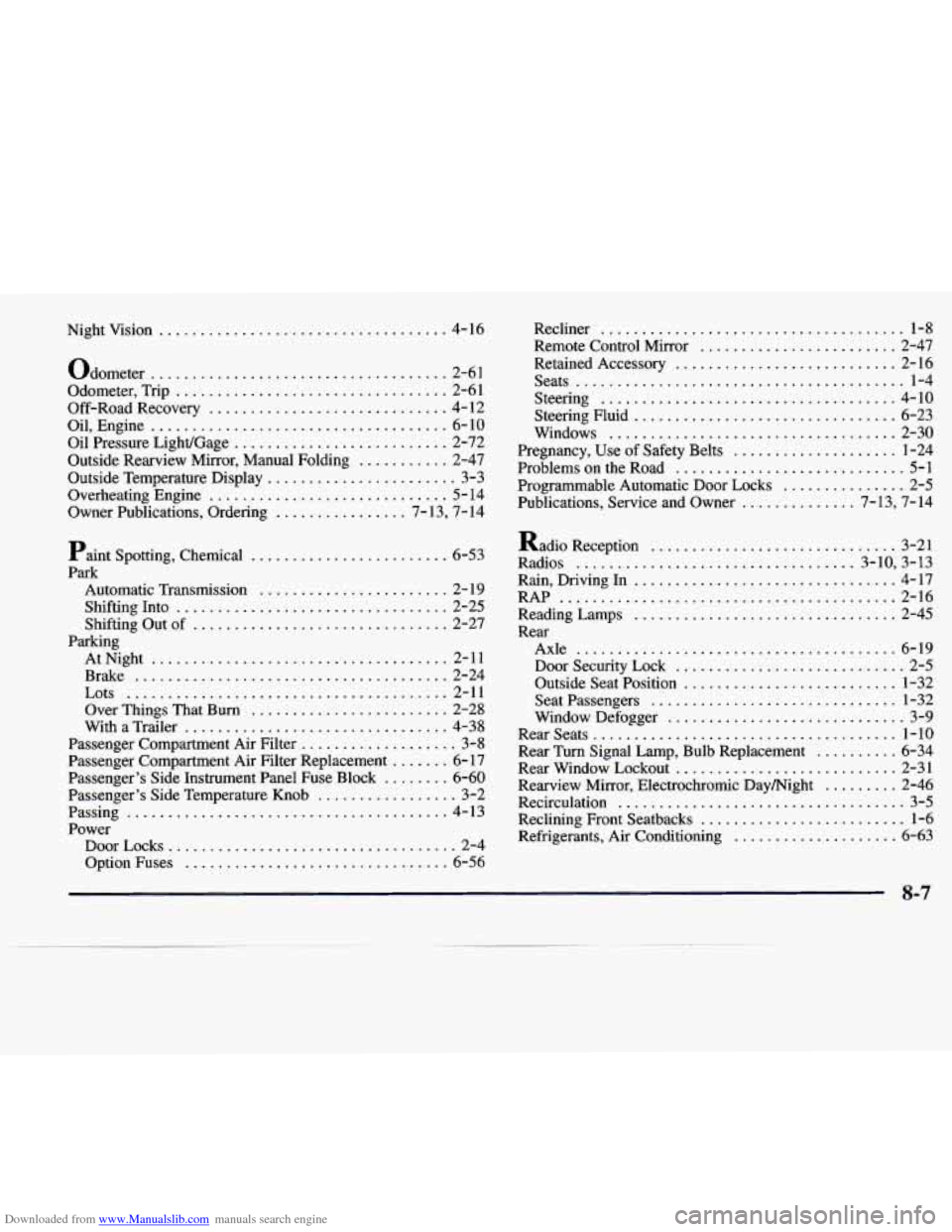
Downloaded from www.Manualslib.com manuals search engine Nightvision ................................... 4-16
Odometer
.................................... 2-6 1
Odometer. Trip
................................. 2-61
Off-Road Recovery
............................. 4- 12
Oil. Engine
.................................... 6-10
Oil Pressure LighVGage
.......................... 2-72
Outside Temperature Display
....................... 3-3
Overheating Engine
............................. 5- 14
Owner Publications. Ordering
................ 7- 13. 7- 14
Outside Rearview Mirror. Manual Folding
........... 2-47
Paint Spotting. Chemical
........................ 6-53
Park
Automatic Transmission
....................... 2- 19
Shifting Into
................................. 2-25
Shifting Out of
............................... 2-27
Parking AtNight
.................................... 2-11
Brake
...................................... 2-24
Lots
....................................... 2-11
Over Things That Burn
........................ 2-28
With a Trailer
................................ 4-38
Passenger Compartment Air Filter
................... 3-8
Passenger Compartment Air Filter Replacement
....... 6-17
Passenger’s Side Instrument Panel
Fuse Block ........ 6-60
Passenger’s Side Temperature Knob
................. 3-2
Passing
....................................... 4-13
Power DoorLocks
................................... 2-4
Option Fuses
................................ 6-56 Recliner
..................................... 1-8
Remote Control Mirror ........................ 2-47
Retained Accessory
........................... 2-16
Seats
........................................ 1-4
Steering
.................................... 4-10
Steering Fluid
................................ 6-23
Windows
................................... 2-30
Pregnancy. Use of Safety Belts
.................... 1-24
Problems
on the Road ............................ 5-1
Programmable Automatic Door Locks
............... 2-5
Publications. Service and Owner
.............. 7- 13. 7- 14
Radio Reception .............................. 3-21
Radios
.................................. 3.10. 3.13
Rain. Driving
In ................................ 4-17
RAP
......................................... 2-16
ReadingLamps
................................ 2-45
Rear Axle
....................................... 6-19
Door Security Lock
............................ 2-5
Outside Seat Position
.......................... 1-32
Seatpassengers
.............................. 1-32
Window Defogger
............................. 3-9
RearSeats ..................................... 1-10
Rear Turn Signal Lamp, Bulb Replacement
.......... 6-34
Rear Window Lockout
........................... 2-31
Recirculation
................................... 3-5
Reclining Front Seatbacks
......................... 1-6
Refrigerants, Air Conditioning
.................... 6-63
Rearview Mirror, Electrochromic
Daymight
......... 2-46
8-7